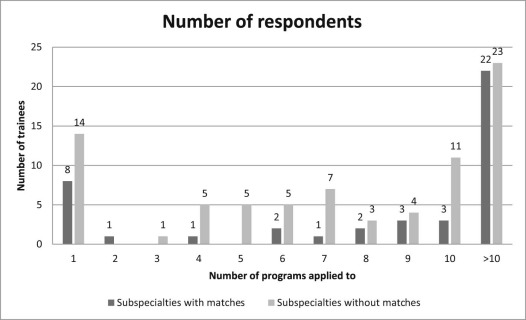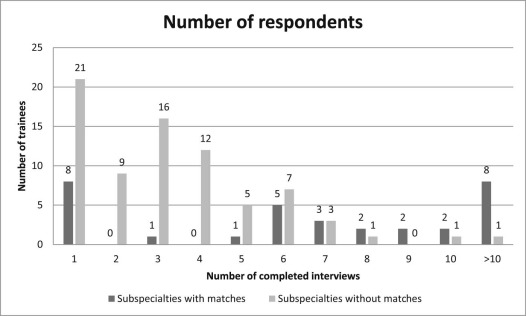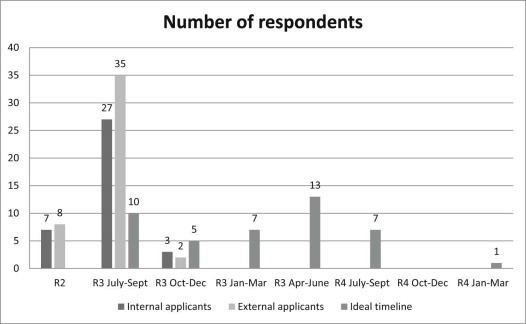Rational and Objectives
This study aimed to assess resident, fellow, and fellowship director perceptions of the musculoskeletal (MSK) radiology fellowship application process.
Materials and Methods
A task group constructed three surveys with questions about current and “ideal” fellowship application and selection processes. Surveys were distributed to MSK fellowship directors, who were also asked to give separate surveys to current fellows. US and Canadian radiology residency directors were asked to distribute surveys to current R3 and R4 residents. Responses were tabulated and analyzed.
Results
Responses were received from 47 MSK fellowship directors, 73 MSK fellows, and 147 residents. Fellowship directors and fellows reported that most fellowship offers occur between July and September of the R3 year, although 19% of directors made offers as early as the R2 year. Of the 43 director respondents, 31 (72%) noted “pressure from other programs” as the main driving force behind their policies, but 28 (65%) felt that their timelines were “too early.” A formal match was supported by 55% of responding fellowship directors, 57% of fellows, and 61.9% of residents, citing “fairness” as a major justification.
Conclusions
MSK radiology fellowship selection occurs as early as the R2 year, before many residents have had substantial exposure to different subspecialties. An “arms race” has developed with programs moving their timelines earlier in response to the actions of other programs, presumably to avoid missing the best candidates. Although a majority of respondents would support a formalized match to increase fairness, there is not universal agreement that it would be the best approach.
Introduction
In the United States, radiology fellowships are 1- or 2-year subspecialty training programs pursued after successful completion of diagnostic radiology residency and its prerequisite clinical internship year. Although fellowship is optional, several surveys suggest that more than 90% of diagnostic radiology residents apply or intend to apply for subspecialty fellowship training . American Board of Radiology (ABR) certification restructuring in 2013 may further affect this trend—candidates are eligible to take the certifying portion of the ABR examination 15 months after the completion of residency, and they have the option to select subspecialty assessment categories on the examination that reflect the clinical focus of their fellowship training and professional practice .
In our search of the medical literature, there have been no published reports investigating resident, fellow, and fellowship director perceptions and preferences of the fellowship application and selection process since the changes to the ABR examination structure in 2013 . Anecdotal experience at our own institutions is that the required radiology curriculum is now compressed into the first 3 years of training in preparation for the ABR core examination, with limited elective time to explore subspecialty interests before applying for fellowship. In musculoskeletal (MSK) radiology, we have noted progressive “application creep,” with an increasing number of interview invitations offered and fellowship positions filled between the end of the second year of diagnostic radiology training (R2) and early third year (R3), before many residents have had the opportunity to fully explore subspecialty interests. Our study objective is to assess resident, MSK fellow, and MSK fellowship director perceptions of the current fellowship application and selection process, and their thoughts about potential changes.
Materials and Methods
Get Radiology Tree app to read full this article<
Get Radiology Tree app to read full this article<
Get Radiology Tree app to read full this article<
Get Radiology Tree app to read full this article<
Get Radiology Tree app to read full this article<
Get Radiology Tree app to read full this article<
Results
Responses of R3 and R4 Residents and MSK Fellows (“Trainees”)
Get Radiology Tree app to read full this article<
Get Radiology Tree app to read full this article<
Get Radiology Tree app to read full this article<
Get Radiology Tree app to read full this article<
Get Radiology Tree app to read full this article<
Responses of MSK Fellowship Directors
Get Radiology Tree app to read full this article<
Get Radiology Tree app to read full this article<
Get Radiology Tree app to read full this article<
Get Radiology Tree app to read full this article<
Get Radiology Tree app to read full this article<
Get Radiology Tree app to read full this article<
Get Radiology Tree app to read full this article<
Responses of MSK Fellowship Directors and Trainees to Survey Questions in Common
Get Radiology Tree app to read full this article<
Get Radiology Tree app to read full this article<
TABLE 1
Perceptions of the Current Nonmatch Fellowship Selection Process
Current Nonmatch Fellowship Selection Process MSK Fellowship Directors (n = 40) MSK Fellows ( n = 61) R3, R4 Residents ( n = 78) Gives residents adequate time to explore all subspecialty options 6 (15%) 18 (30%) 19 (24.4%) Conflicts with other residency obligations 11 (28%) 22 (37%) 32 (41.0%) Restricts options for a “back-up plan” if not accepted into subspecialty of choice 15 (38%) 30 (50%) 35 (46.1%) Gives applicants time to interview at all programs they are interested in 9 (23%) 15 (25%) 21 (27.3%) Fair to applicants 9 (23%) 30 (51%) 28 (36.4%) Fair to fellowship training programs 12 (30%) 38 (66%) 41 (54.0%) Common application would simplify the process 31 (80)% 51 (86%) 73 (96.1%)
MSK, musculoskeletal.
TABLE 2
Perceptions of the Official Fellowship Match as Managed by the NRMP
Official Fellowship Match as Managed by the NRMP MSK Fellowship Directors ( n = 39) MSK Fellows ( n = 61) R3, R4 Residents ( n = 116) Gives residents adequate time to explore all subspecialty options 31 (80%) 42 (74%) 88 (76.5%) Conflicts with other residency obligations 11 (28%) 32 (58%) 71 (61.2%) Restricts options for a “back-up plan” if not accepted into subspecialty of choice 20 (54%) 30 (53%) 80 (70.8%) Gives applicants time to interview at all programs they are interested in 35 (92%) 48 (84%) 99 (85.3%) Fair to applicants 32 (84%) 51 (88%) 98 (85.2%) Fair to fellowship training programs 28 (74%) 55 (95%) 101 (87.8%) Common application would simplify the process 34 (89%) 48 (84%) 108 (93.1%)
MSK, musculoskeletal; NRMP, National Residency Match Program.
Get Radiology Tree app to read full this article<
Discussion
Get Radiology Tree app to read full this article<
Get Radiology Tree app to read full this article<
Get Radiology Tree app to read full this article<
Get Radiology Tree app to read full this article<
Get Radiology Tree app to read full this article<
Get Radiology Tree app to read full this article<
Get Radiology Tree app to read full this article<
Supplementary Data
Get Radiology Tree app to read full this article<
Appendix S1
Get Radiology Tree app to read full this article<
Get Radiology Tree app to read full this article<
Get Radiology Tree app to read full this article<
References
1. Baker S.R., Luk L., Clarkin K.: The trouble with fellowships. J Am Coll Radiol 2010; 7: pp. 446-451.
2. Shetty A., Hammer M., Gould J., et. al.: Results of the 2014 survey of the American Alliance of Academic Chief Residents in Radiology. Acad Radiol 2014; 21: pp. 1331-1347.
3. American Board of Radiology : Certifying exam. Available at https://www.theabr.org/diagnostic-radiology/initial-certification/certifying-exam
4. Mulcahy H., Chew F.S., Mulcahy M.J.: The radiology fellowship application and selection process in the United States: experiences and perceptions from both sides. Radiol Res Pract 2012;
5. Accreditation Council for Graduate Medical Education : Number of accredited programs and on-duty residents for the academic year by specialty. Available at https://apps.acgme.org/ads/Public/Reports/Report/3
6. Accreditation Council for Graduate Medical Education : ACGME data resource book. Available at http://www.acgme.org/About-Us/Publications-and-Resources/Graduate-Medical-Education-Data-Resource-Book/articleid/5313
7. Gay S.B., Resnik C.S., Harolds J.A., et. al.: The radiology fellowship and fellowship match: current status. Acad Radiol 2003; 10: pp. 303-308.
8. Chen J.Y., Agarwal V., Orons P.D.: Competitiveness of the match for interventional radiology and neuroradiology fellowships. J Am Coll Radiol 2014; 11: pp. 1069-1073.
9. Society of Interventional Radiology : IR residency and fellowship. Available at https://www.sirweb.org/learning-center/ir-residency/
10. Society of Breast Imaging : Fellowship and match program. Available at https://www.sbi-online.org/RESOURCES/FellowshipsandMatchProgram.aspx


